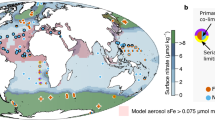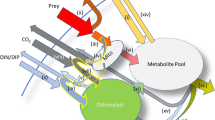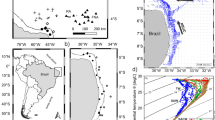Abstract
The realization that natural assemblages of planktonic bacteria may acquire a significant fraction of their nitrogen and phosphorus via the uptake of dissolved inorganic nutrients has modified our traditional view of these microorganisms as nutrient remineralizers in plankton communities. Bacterial uptake of inorganic nitrogen and phosphorus may place bacteria and phytoplankton in competition for growth-limiting nutrients, rather than in their traditional roles as the respective “source” and “sink” for these nutrients in the plankton. Bacterial nutrient uptake also implies that bacterivorous protozoa may play a pivotal role in the remineralization of these elements in the microbial loop. The overall contribution of bacterial utilization of inorganic nutrients to total nutrient uptake in the ocean is still poorly understood, but some generalizations are emerging with respect to the geographical areas and community physiological conditions that might elicit this behavior.
Similar content being viewed by others
References
Benner R, Pakulski JD, McCarthy M, Hedges JI, Hatcher PG (1992) Bulk chemical characteristics of dissolved organic matter in the ocean. Science 255:1561–1564
Bratbak G, Thingstad TF (1985) Phytoplankton-bacteria interactions: an apparent paradox? Analysis of a model system with both competition and commensalism. Mar Ecol Prog Set 25:23–30
Caron DA (1991) Evolving role of protozoa in aquatic nutrient cycles. In: Reid PC, Turley CM. Burkill PH (ed) Protozoa and their role in marine processes, vol 25. Springer-Verlag, Berlin, pp 387–415
Caron DA, Goldman JC, Dennett MR (1988) Experimental demonstration of the roles of bacteria and bacteriovorous protozoa in plankton nutrient cycles. Hydrobiologia 159:27–40
Cole JJ, Findlay S, Pace ML (1988) Bacterial production in fresh and saltwater ecosystems: a cross-system overview. Mar Ecol Prog Set 43:1–10
Currie DJ, Kalff J (1984) A comparison of the abilities of freshwater algae and bacteria to acquire and retain phosphorus. Limnol Oceanogr 29:298–310
Fenchel T, Finlay BJ (1983) Respiration rates in heterotrophic, free-living protozoa. Microb Ecol 9:99–122
Jürgens K, Güde H (1990) Incorporation and release of phosphorus by planktonic bacteria and phagotrophic flagellates. Mar Ecol Prog Ser 59:271–284
Kirchman D (1994) The uptake of inorganic nutrients by heterotrophic bacteria. Microb Ecol 28:255–271
Suttle CA, Fuhrman JA, Capone DG (1990) Rapid ammonium cycling and concentration-dependent partitioning of ammonium and phosphate: implications for carbon transfer in planktonic communities. Limnol Oceanogr 35:424–433
Wheeler PA, Kirchman DL (1986) Utilization of inorganic and organic nitrogen by bacteria in marine systems. Limnol Oceanogr 31:998–1009
Author information
Authors and Affiliations
Rights and permissions
About this article
Cite this article
Caron, D.A. Inorganic nutrients, bacteria, and the microbial loop. Microb Ecol 28, 295–298 (1994). https://doi.org/10.1007/BF00166820
Issue Date:
DOI: https://doi.org/10.1007/BF00166820




